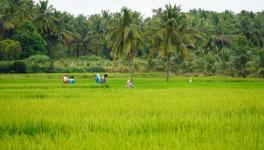Liberalisation of Agriculture: Lessons from Developed and Developing Countries
It has now been three months since farmers and agricultural workers from various Indian states have been agitating at the borders of Delhi demanding that the three farm laws be repealed. The farmers have argued that the implementation of these laws will result in falling prices for their agricultural produce, increased costs of cultivation and increased indebtedness. They fear that this economic situation will force them into selling their lands.
They also argue that the new laws will eventually lead to the dismantling of the public procurement system (under which the government procures from farmers at a pre-decided Minimum Support Price (MSP)), which is intrinsically connected with the public distribution system, ensuring food security and food sovereignty in the country.
They fear that the entry and subsequent dominance of large agri-businesses and corporations over the agricultural sector will convert them into wage labourers on their own land. This dominance by giant corporations, it has been argued, will lead to a further marginalisation of small and marginal farmers, inevitably also affecting the livelihood of agricultural labourers.
Despite this historic resistance by the farming community, the central government continues to defend farm laws as a much needed reform in the agricultural sector, that will benefit the farmers in the long run. In one of his addresses to the nation over his radio show Mann ki Baat, PM Modi said, “Parliament has recently passed farm reform laws after rigorous brainstorming. These reforms have not only broken shackles of farmers but have also given new rights and opportunities to them.”
Taking the defence of farm laws ahead a few days ago, he asserted that the reforms will benefit small and marginal farmers and exhorted farmers to give these laws a chance. Liberalisation of agriculture through legislations such as the farm laws introduced by the Indian government has been tried and tested in other parts of the world and there is much to learn from these experiences.
Extending solidarity to the struggle of Indian farmers, 87 farmers’ unions from US argued that what the Indian farmers are enduring now had happened in the US almost four decades ago. The Reagan administration enforced deregulatory policies and eroded parity prices (the equivalent of MSP in the US).
Also read: Why Does the US Support the Three Farm Laws?
These policies have disproportionately benefited large farmers with the means to consolidate for growing monoculture commodity crops like corn or soy. Traditional producers and small farmers find it hard to survive with their meagre agricultural incomes and end up supplementing it with other sources of income. The suicide rates in rural America are 45% higher than in urban areas.
Similar efforts were undertaken in the UK to ensure a shift of population from the agriculture to industry. As a result, between 19th century and now, the rural population in UK has reduced from 65.2% to 17%. Agricultural landholdings have reduced from 4.5 lakh to 2.17 lakh while the population has doubled from 3.1 crore to 6.6 crore. While the top four supermarkets provide for 70% of groceries in UK, farmers only get 8% of the total money spent on food. Even the subsidies provided to farmers have been reduced substantially making farming economically unviable for them.
In the developing world, agricultural market liberalisation measures were introduced in many parts of Latin America, South Asia and Africa along with the structural adjustment programmes in the 1980s and 90s. In the 1980s, most African governments initiated agricultural market liberalisation programmes to: 1) eliminate government control over input and output pricing and distribution and; 2) eliminate regulatory controls over input and output marketing.
A research sponsored by UK Department for International Development reveals that agricultural liberalisation in sub-Saharan Africa has failed the people of Africa and its outcomes have been disappointing. While the reforms have yielded benefits to producers and consumers of selective crops, it has failed to deliver the benefits that had been promised for the producers of food crops and poorer farmers from rural areas. The report also argues that the reforms have not delivered the ‘broad-based agricultural transformation needed as a base for wider poverty reducing growth.’
Also read: Assurances Not Enough to Convince Farmers on Security of MSP Regime
In Kenya, over 20 legislations were repealed to encourage the participation of agribusinesses in crop markets. A recent research from the London School of Economics shows that these legislative changes led to an increase in profits made by agri-businesses but at the same times resulted in a fall in the incomes of the farmers selling to agri-businesses by an average of 6%. The overall market share of agri-businesses as buyers of farm-produce almost doubled, reaching 38% by 2010 and their profit margins rose by 5%.
The farmers that had begun to sell their crops to agri-businesses stopped selling to it them in a matter of few years. A monopsonistic situation had been created where the farmers found themselves facing bigger and fewer buyers in crop markets. The research further highlights that the farmers selling to agribusinesses are often large farmers having higher incomes, while the incomes of small farmers witness a decline.
Reports from Ghana reveal that the policy of import liberalisation has resulted in small farmers being displaced from their own domestic market as a result of intense competition from import of rice, tomato, and poultry. This has resulted in a decline of the production of the three crops and the share of local products in national consumption.
Further, the competition arising from these imports has been unfair in many cases as the imports from developed countries are heavily subsidised and their prices are artificially cheapened. On the other hand, small farmers in developing countries do not receive heavy subsidies. Even the assistance provided by the governments in the developing world has been substantially reduced as a result of structural adjustment policies crafted and influenced by the World Trade Organisation (WTO) and International Monetary Fund (IMF). Heavily subsidised imports from the developed countries have further marginalised the local Ghanaian farmers who receive little state support.
Liberalisation of agriculture markets has further meant that governments in several regions in Africa have shifted their priority away from food crops to export crops or cash crops. More land resources started to be devoted to export crops and less to domestic food production.
In Benin, the government incentives led to an increase in land under cultivation of cotton for exports. Evidence from Uganda points to an emphasis on export of both traditional and non-traditional cash crops and a decline in production of food crops consumed locally. The experience of African states that have implemented reforms to liberalise agriculture can be summed up in the words of the former Deputy Governor of the Central Bank of Kenya, Herzon Nyangito as - "liberalised trade, including WTO trade agreements, benefits only the rich while the majority of the poor do not benefit but are instead made more vulnerable to food insecurity."
Also read: Farmers vs Capitalism: The Neoliberal Mercenaries of Caste Politics
Finally, an important development in Africa after liberalisation of agriculture has been direct or indirect privatisation of African communal lands. Large tracts of land in Africa, previously occupied by its poor indigenous population is being purchased or taken on lease by foreign nations, companies or individuals for agricultural production. Target countries include Ethiopia, Kenya, Malawi, Mali, Mozambique, Sudan, Tanzania, Zambia, Cameroon, the Democratic Republic of Congo, Madagascar, Somalia and Sudan. Between 2004 and 2009 alone, at least 2.5 million hectares of land were transferred. Some of the biggest investors acquiring land in Africa include Middle Eastern countries such as Saudi Arabia, Qatar, Kuwait and Abu Dhabi.
The experiences of agricultural liberalisation and its impact on small farmers from both developed and developing countries show that the concerns raised by Indian farmers protesting against farm laws are neither unfounded nor unprecedented.
The extension of solidarity of farmers’ and workers’ organisations from different corners of the world to the ongoing farmers’ movement in India also proves that the model of agrarian development championed and propagated by the developed world needs to be sincerely investigated before being adopted as a wholesale package by developing countries like India.
(The writer is an author and a research associate with NewsClick. The views are personal.)
Get the latest reports & analysis with people's perspective on Protests, movements & deep analytical videos, discussions of the current affairs in your Telegram app. Subscribe to NewsClick's Telegram channel & get Real-Time updates on stories, as they get published on our website.























